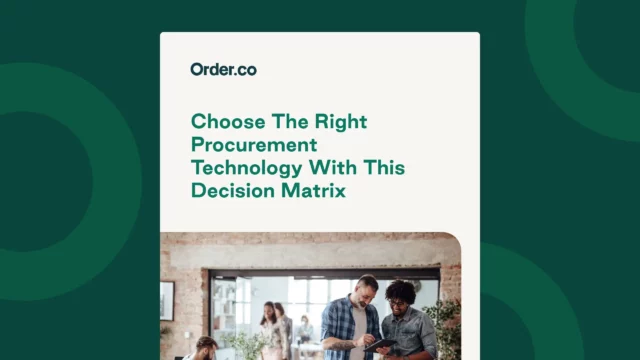A Mid-Market Buyer’s Guide to Procure-to-Pay (P2P) Platforms

A Mid-Market Buyer’s Guide to Procure-to-Pay (P2P) Platforms
As mid-market companies scale, the simple act of buying things gets complicated—fast. What once worked for a small team—manual purchase orders, a handful of vendors, and scattered invoices—quickly becomes a source of chaos. Finance and operations leaders find themselves battling fragmented purchasing, uncontrolled spending, and a mountain of manual work that drains time and budget.
The solution is a procure-to-pay (P2P) platform, but choosing the right one is a challenge. Most buyer’s guides offer a simple feature checklist, which fails to address the unique needs of a growing business. This guide provides a better evaluation framework, helping you look beyond features to find a solution that delivers real-world outcomes like total spend control, operational efficiency, and financial flexibility.
Download the free ebook: Choose the Right Procurement Technology With This Decision Matrix
What is a procure-to-pay platform?
A procure-to-pay (P2P) platform is an end-to-end software solution that automates and connects the entire purchasing lifecycle, from the initial request for a product or service to the final vendor payment. It unifies every step of the procurement process into a single, cohesive system.
For mid-market companies, a P2P platform brings order to the chaos of decentralized buying. Instead of juggling spreadsheets, email chains, and multiple vendor websites, teams work within one system that provides clarity and control. This helps solve critical operational challenges like maverick spend, invoice overload, and a lack of visibility into where money is actually going.
The typical P2P cycle includes:
- Requisition: An employee identifies a need and submits a purchase request.
- Approval: The request is routed through a predefined workflow for approval from managers or department heads.
- Sourcing and Purchasing: The approved request becomes a purchase order sent to a vetted supplier.
- Receiving: The goods or services are received, and delivery is confirmed.
- Invoice Reconciliation: The vendor invoice is matched against the purchase order and receiving report (3-way matching).
- Payment: Once reconciled, the invoice is approved and paid through the system.
Why standard P2P platform comparisons fall short
Standard P2P platform comparisons often fall short because they rely on generic feature checklists that don’t account for the specific, dynamic needs of scaling mid-market businesses. While features like "invoice automation" or "supplier portals" are important, a simple checkmark doesn’t tell you how a platform will actually perform or what business outcomes it will drive.
These traditional evaluations miss the bigger picture. They fail to highlight how a platform can strategically manage a complex supplier network, optimize cash flow with flexible financial tools, or provide an intuitive user experience that ensures company-wide adoption. Focusing only on features can lead you to a solution that technically "works" but doesn't solve your core problems of controlling costs and improving efficiency as you grow.
A better P2P evaluation framework for mid-market companies
A better evaluation framework for mid-market companies moves beyond a feature list to assess platforms based on core business outcomes: spend control, operational efficiency, strategic sourcing, and financial flexibility. This approach helps you ask the right questions and build a procure-to-pay comparison that truly reflects your business needs.
Use this decision matrix to guide your evaluation and conversations with potential vendors.
Spend control and visibility
For growing businesses, gaining control over spending is the top priority. A P2P platform should provide complete visibility into every transaction, from request to payment, and give you the tools to enforce purchasing policies automatically.
- What to look for: A centralized purchasing experience, customizable approval workflows by role or location, real-time budget tracking, and robust procurement analytics.
- Questions to ask vendors:
- How does your platform prevent unauthorized or out-of-policy purchases?
- Can we create unique approval chains for different departments, locations, or spending thresholds?
- What kind of dashboards and reports are available for spend analysis?
Operational efficiency and automation
Manual tasks are a significant drain on resources. The right P2P platform should eliminate repetitive work for your finance, operations, and procurement teams, freeing them to focus on more strategic initiatives.
- What to look for: Fully automated purchase order processing, 3-way matching, invoice processing, and payment reconciliation. Look for a platform that integrates seamlessly with your existing ERP or accounting software.
- Questions to ask vendors:
- How does your platform integrate with systems like NetSuite, Sage Intacct, or QuickBooks?
- How much manual work is eliminated from our accounts payable process?
- Can you walk me through the lifecycle of an order, from request to payment, in your system?
Strategic sourcing and supplier management
Managing dozens or hundreds of vendors creates complexity and missed savings opportunities. A great P2P platform simplifies supplier management and helps you make smarter sourcing decisions.
- What to look for: A unified B2B marketplace or curated catalog, AI-powered sourcing tools for price comparison, vendor consolidation features, and supplier performance tracking.
- Questions to ask vendors:
- Can we continue using our existing vendors on your platform?
- How does your system help us find new suppliers or get better pricing on products we already buy?
- Do you centralize all purchasing into a single shopping cart and one consolidated invoice?
Financial flexibility and working capital
Cash flow is the lifeblood of a mid-market company. Modern P2P platforms go beyond just processing payments; they offer embedded financial tools that help you optimize your working capital management.
- What to look for: Embedded fintech solutions like flexible net terms, B2B Buy Now, Pay Later (BNPL) options, and simplified, automated payment processing that helps you manage cash flow more effectively.
- Questions to ask vendors:
- How does your platform handle vendor payments? Do we pay you, or do we pay each vendor individually?
- Do you offer extended or variable payment terms to help us manage our cash conversion cycle?
- What options are available if we need short-term capital to fund large purchases?
The unique advantage of a unified marketplace with embedded fintech
The best procure-to-pay software goes beyond just automating workflows. A platform that combines a unified B2B marketplace with embedded financial tools offers a strategic advantage by controlling spend at its source and proactively optimizing your company’s financial health.
A unified marketplace transforms business buying into a simple, guided experience. Instead of employees purchasing from countless websites, they shop from a single, curated catalog containing pre-approved products from all your vendors. This approach enforces compliance before a purchase ever happens, eliminating rogue spend and ensuring brand standards are met across all locations.
When this marketplace is paired with embedded fintech, the entire payment process is simplified. Instead of managing hundreds of vendor invoices and payment schedules, your AP team receives one consolidated invoice from the platform and makes one payment. This structure also enables powerful financial tools, like extended net terms, giving you the flexibility to pay on a schedule that works for your cash flow—not your vendors'.
How to choose the best procure-to-pay software for your business
The best P2P platform is the one that aligns with your specific operational challenges, growth trajectory, and existing technology. Follow these steps to make a confident, data-driven decision.
- Assess your current process: Document your entire P2P workflow and identify the biggest pain points. Are approvals taking too long? Is your AP team drowning in invoices? Are you constantly surprised by budget overruns?
- Define your goals: Establish clear, measurable objectives. Are you aiming to reduce product costs, cut invoice processing time, or gain 100% visibility into spending?
- Involve key stakeholders: Your P2P platform will be used by multiple departments. Get input from Finance, Operations, Procurement, IT, and the end-users who will be making purchase requests to ensure buy-in.
- Schedule demos and ask targeted questions: Use the evaluation framework in this guide to lead your vendor conversations. Go beyond the sales pitch and ask to see how the platform solves your specific problems.
- Prioritize ease of use and implementation: A powerful platform is only valuable if your team uses it. Choose a solution with an intuitive interface and a clear onboarding plan to ensure successful adoption.
Bring order to your procurement
Order.co is the only procure-to-pay platform designed to give mid-market companies total control over their spend by unifying the entire purchasing lifecycle. It combines a guided B2B marketplace, end-to-end automation, and embedded financial offerings to simplify how your business buys.
Unlike other purchase-to-pay solutions for mid-market companies that just automate existing processes, Order.co transforms them.
- Unmatched spend control: Its curated catalogs and dynamic approval workflows eliminate rogue spending and ensure every purchase is on-policy and on-budget.
- Effortless efficiency: Order.co automates every step of the P2P cycle and integrates seamlessly with your accounting system, giving your AP team hundreds of hours back.
- AI-powered strategic sourcing: The platform analyzes your spend and leverages a network of over 15,000 vendors to find you the best products at the best prices, saving an average of 5% on product costs.
- Unrivaled financial flexibility: With Consolidated Billing, flexible Net Terms, and capital offerings, we help you optimize your cash flow and scale with confidence.
Ready to see how a modern P2P platform can transform how your business buys? Schedule a demo of Order.co today.
Get started
Schedule a demo to see how Order.co can simplify buying for your business.
"*" indicates required fields



